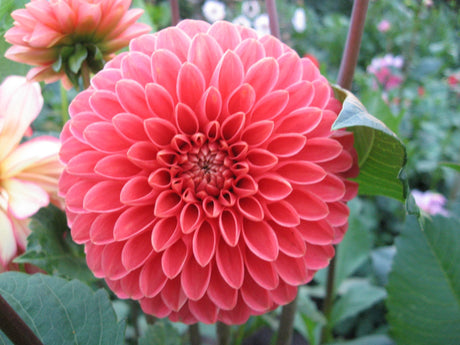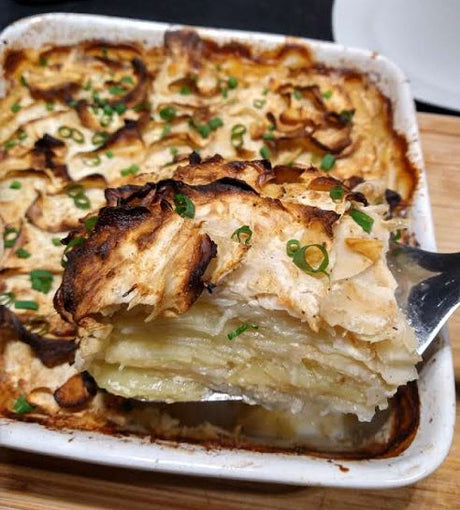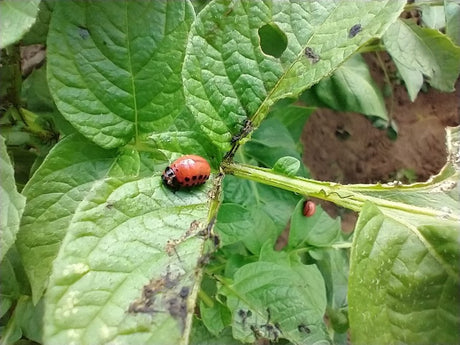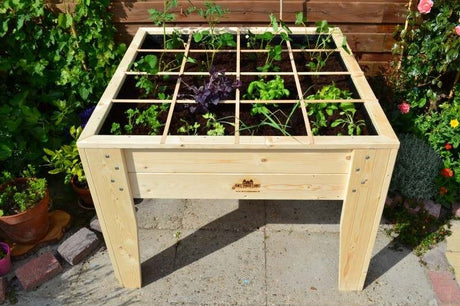Even as a seasoned gardener, you won't believe your eyes when you pull your first bulb out of the ground. Growing elephant garlic is not that difficult. Especially if you've read this growing guide.
Elephant garlic, also known as giant garlic or with a Latin name Allium ampeloprasum var. ampeloprasum , is a unique type of garlic. It is known for large bulbs with a mild yet complex flavor. This garlic is not only a delicious addition to your dishes, but also relatively easy to grow. In this growing guide, you will learn everything you need to know about successfully growing elephant garlic.
Soil Requirements for Elephant Garlic
Elephant garlic likes well-drained, fertile soil. Make sure the soil is rich in organic matter. It is advisable to improve the soil before planting with compost or well-rotted manure to provide nutrition and better drainage. The pH of the soil should be between 6.0 and 7.0, which is the case in most gardens.

Light and Temperature
Elephant garlic thrives in a sunny location . Choose a spot in your garden that gets at least 6 to 8 hours of sunlight per day. This variety of garlic is hardy and can withstand (freezing) temperatures, meaning it can be planted in early spring or fall.
Growing period
It is best to plant this garlic in the fall or early in the year. You can expect the harvest in early summer. If you planted in the fall, you can expect even larger bulbs of elephant garlic.
Planting instructions
|
Choose the elephant garlic clovesUse large, healthy cloves of garlic for best results. Avoid small or damaged cloves. |
Depth and distancePlant the loose cloves about 10-15 cm deep with a distance of 20-30 cm between the cloves. |
Organic materialAdd some mulch after planting to keep the soil moist and minimize weed growth. |
Watering
Elephant garlic needs constant moisture. Especially during the growing season. Make sure the soil never feels too dry . Avoid overwatering. Too much water can lead to root rot.
Weed and Pest Control
Keep the area around the garlic weed free. Weeds can compete for nutrients and water. Pests such as aphids and thrips should also be monitored. Use organic pesticides if necessary.
Harvesting Elephant Garlic
Harvesting elephant garlic can be done easily in three steps, provided you choose the right time and are careful not to damage the bulbs. Follow these steps:
- Step 1: Choose the right time: Elephant garlic is ready to harvest when the leaves begin to yellow and die, usually in late summer or early fall (about 8-10 months after planting). This is a sign that the bulbs are mature. Don't wait too long, as too many wilted leaves can reduce bulb quality.
- Step 2: Carefully dig around the bulb: Use a garden fork or shovel to carefully dig around the plant, about 4-6 inches from the base of the plant so as not to damage the roots and bulb. Pry the bulb loose from the ground, and pull the plant out of the ground with the leaves attached.
- Step 3: Let the bulbs dry. Gently clean the bulbs by shaking off any excess soil, but avoid washing them. Hang the bulbs or place them in a well-ventilated area, such as a dry shed or garage, to dry. After two to three weeks, they will be ready to store or use. These steps will help maintain the quality of your elephant garlic and ensure optimum flavor and shelf life.


Storing Elephant Garlic
There are several ways to store elephant garlic to best preserve its freshness and flavor. Here are some storage tips:
-
At room temperature
Store in a dry, cool place with good air circulation, such as a cupboard or pantry. Avoid damp places, such as the refrigerator, as this can lead to mould and germination. In a dark, well-ventilated space, elephant garlic can last up to 3 months. In the refrigerator (only for peeled or chopped garlic)
If you have already peeled or cut cloves, you can store them in an airtight container in the refrigerator. Make sure the garlic is dry, and use it within a week, because it quickly loses flavor and quality.Freeze
For longer storage, you can freeze giant garlic. Peel the cloves and chop them finely or puree them. Pack the garlic in airtight bags or small containers and freeze them. This way, your harvest will last up to 6 months, but keep in mind that the texture will change slightly after thawing.Store in oil (with caution)
You can store this type of garlic in oil for a short time (a few weeks), provided that it is kept in the refrigerator. However, this must be done carefully to prevent the growth of bacteria, such as botulism. Do not store the garlic in oil for more than a week and make sure that it remains in the refrigerator.Drying or smoking
Another way to make giant garlic last longer is to dry or smoke it. For example, you can dry it in a dehydrator or let it air dry. Dried garlic can be ground into garlic powder or stored as whole cloves in an airtight jar.
These methods will help you maximize the flavor and quality of your elephant garlic, depending on how quickly you plan to use it.
Dishes with elephant garlic
Elephant garlic, also known as giant garlic, has a milder flavor than regular garlic and is delicious in a variety of dishes.
Here you will find my top 5 best dishes in which elephant garlic really comes into its own:
Roasted Elephant Garlic as a Side Dish
Cut a bulb of elephant garlic in half horizontally, sprinkle with olive oil, salt and pepper and roast in the oven (about 45 minutes at 180°C). The garlic will soften and get a sweet, mild flavour. Delicious to spread on bread or with grilled vegetables.Pasta with Elephant Garlic and Lemon
Make a simple pasta by heating olive oil with thinly sliced elephant garlic until lightly golden. Add lemon juice, lemon zest, a pinch of red pepper flakes, and your favorite fresh herbs (like basil or parsley). Toss with cooked pasta and optionally Parmesan cheese for a fresh, slightly spicy pasta.Elephant Garlic Aioli
Make a homemade aioli by finely mashing elephant garlic and mixing it with mayonnaise, a little lemon juice, salt and pepper. This gives a subtle garlicky flavour that is delicious with fries, grilled vegetables and bread.Creamy Elephant Garlic Soup
Roast elephant garlic with onion and carrot, puree and add to a base of vegetable stock and cream for a creamy, tender garlic soup. Garnish with fresh herbs such as chives or thyme. The soup gets a mild, rich flavour from the elephant garlic.Grilled Chicken with Elephant Garlic and Rosemary
Make a marinade of olive oil, finely chopped elephant garlic, fresh rosemary, lemon juice and black pepper. Marinate chicken fillets or chicken thighs in this mixture and grill or bake the chicken. The elephant garlic gives a light garlic note that goes perfectly with rosemary and lemon.
Each of these dishes showcases the mild, aromatic flavour of elephant garlic. Its milder flavour makes it a good fit for both subtle and bold dishes.
Finally
With this growing guide you are well prepared to grow elephant garlic in your garden. It requires some attention, but with the right conditions and attention you will bring flavor bombs into your kitchen.
In the kitchen, use as many cloves of elephant garlic as you would use regular garlic. Because of the milder taste, it comes down to the same thing. Good luck and enjoy the delicious dishes you can make all year round with your own cultivated elephant garlic!
These are my favorites for growing elephant garlic:













